Top News
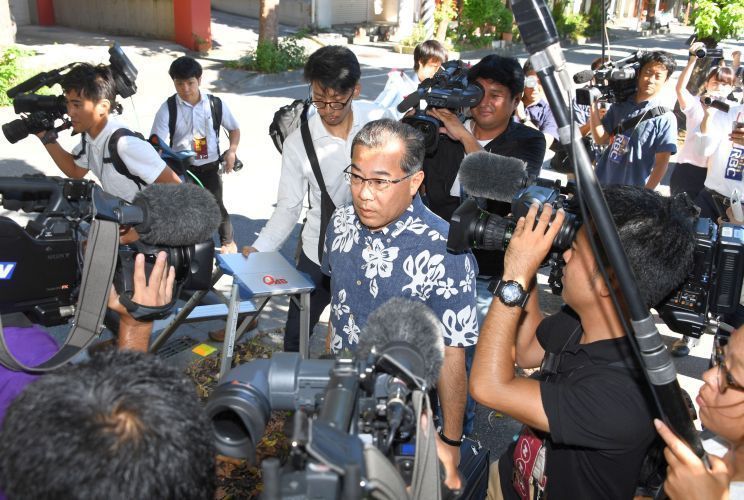
July 22, 2016 Ryukyu Shimpo Digital Edition
In the conflict over the construction of a new U.S. military base in Henoko, Nago City as part of the relocation of U.S. Marine Corps Air Station Futenma, the central government files a lawsuit against the Okinawa prefectural government shortly before 9 a.m. on July 22, arguing that it was illegal for Okinawa governor Takeshi Onaga not to comply with a rectification order from the national government demanding that he reinstate the Henoko land reclamation permit he had nullified. The lawsuit, filed with the Naha branch of the Fukuoka High Court, seeks recognition from the court of the illegality of the governor’s alleged negligence. Previously, the national and prefectural governments had reached an out-of-court settlement in a previous lawsuit in which the national government had sued the prefectural government in order to be able to execute the land reclamation authorization by proxy. They are now clashing again in court after a respite of over four months. Confrontation between the national government and the prefectural government, which was calling for a solution based on dialogue, is sure to deepen.
Just before 9 a.m. on July 22, two employees of the Naha District Legal Affairs Bureau submitted the complaint to the Naha branch of the High Court amidst a throng of reporters.
In accordance with the Local Autonomy Law, the first oral hearing will be held in early August. The presiding judge is expected to be Toshiro Tamiya, the same judge who facilitated a settlement in the proxy execution lawsuit. The court will deliberate on the legality of the government’s rectification order and the prefecture’s nullification of the reclamation permit.
In response to an appeal by the Okinawa prefectural government, the Committee for Settling National-Local Disputes, a review board affiliated with the Ministry of Internal Affairs and Communications, was ultimately unable to come to a judgement on the illegality of the national government’s rectification order. Instead it published a conclusion urging both parties to engage in discussions. Therefore, even after the July 21 deadline, the prefectural government did not file a lawsuit demanding that the rectification order be nullified, instead calling for continued discussions.
On the morning of July 21, Governor Onaga was notified of the government’s plan to sue him at a meeting between the prefectural and national governments at the Prime Minister’s Office. Onaga criticized the national government’s stance, saying, “The way they decided immediately to file a lawsuit, it was as if they were just waiting for the day it would become possible to sue. It is very unfortunate.”
It is the first time for the national government to file an “action for declaration of illegality of inaction” against a local government body since the type of lawsuit came into being along with the revision of the Local Autonomy Law in 2012
(English translation by T&CT and Sandi Aritza)
Go to Japanese
July 22, 2016 Ryukyu Shimpo online edition
On July 22 at about 6 a.m., the Okinawa Defense Bureau (ODB) announced that new helipad construction work at the Northern Training Area, which is located in Higashi Village and Kunigami Village, had begun. Materials and vehicles to be used to start construction had already been moved to the area surrounding the planned construction site.
The planned site for new helipad construction falls into three zones of the Northern Training Area. Twenty construction vehicles or more entered through the H and G zone gates successively, on roads blocked by officials of the ODB. Three such vehicles also approached the gate behind the N1 zone and unloaded iron plates, metal pipes, and other materials in front of the gate.
Starting a bit past 2 a.m., about sixty sit-in protesters spread out on Prefectural Route 70 to the north and south of the N1 zone gate respectively. In the neighborhood of the N1 zone gate, citizens parked about 100 cars along the right and left sides of the prefectural route. Dozens of cars were parked in the center of the highway, effectively blocking the road.
After 3 a.m. on the grounds of Aha Dam in Aha, Kunigami Village, thirty or more riot police vehicles and about twenty ODB cars arrived and waited there. In several places about twenty riot police officers gathered and spoke with diagrams in-hand.
Prefectural riot police officers took position in large numbers on the Higashi Village and Kunigami Village sides of the N1 zone gate starting at about 5:00 in the morning.
At around 5:30 a.m., dozens of riot police officers got out of their vehicles and entered the N1 zone gate from the north. The riot police scuffled with sit-in protesters. They began removing citizens’ vehicles parked in front of the N1 zone gate at 6:42 in the morning.
(English translation by T&CT and Erin Jones)
Go to Japanese

July 14, 2016 Ryukyu Shimpo
In April, the Ryukyu Performers Connection (RPC) agency was set up to allocate dancers, street performers, artists and other performers in Okinawa to various events. The agency will be a single point of contact for event managers and performers to negotiate casting for events. This will be more efficient than in the past, when individual performers had to be contacted.
The RPC will also focus on promoting talented performers who have not yet had much chance to perform. It was set up when a group of Okinawan performers decided to band together to make it easier for event managers and performers to connect.
Twenty-five groups including talented balloon artist “Clown Fanky!” and impersonator of Michael Jackson “Eikel Jackson” belong to the new agency. RPC has already sent performers to the Okinawa International Film Festival.
Representative of RPC Junji Nakasone, who acts as basketball performer “JJ,” says, “Although it has been said that entertainment in Okinawa is weak, there are many great performers. If we advertise Okinawan performance well and promote it as a brand, it will become a new Okinawan attraction.”
URL of Ryukyu Performers Connection is http://rp-connection.com/
(English translation by T&CT and Megumi Chibana)
Go to Japanese

July 18, 2016 Ryukyu Shimpo
On July 17, a research team working on a project for the National Museum of Nature and Science sailed grass boats for the first time from Yonaguni Island to the water between Taketomi Town and Iriomote Island. The project is meant to investigate routes humans 30,000 years ago traversed to come to the Japanese islands, and the team is hastening preparations to verify whether or not these humans came on grass boats. On that morning at about 7 a.m. two grass boats were launched from Kataburu-hama on the south side of Yonaguni. It was decided that the voyage was to take a break at night as the current is generally swift, and sailing would be resumed at 5 a.m. on July 18.
Rowers on the boats are residents of Yonaguni and Iriomote, with seven people in each boat. The team is aiming to have the boats traverse the hypothesized route at two kilometers per hour without the use of equipment, relying on only the sun and stars, wind’s direction, island silhouettes, and such natural indications of position. The rowers are attempting to travel 75 kilometers east to Iriomote on a direct course with accompanying boats carrying additional rowers.
The research team had hypothesized that the trip would only take 30 hours, but due to the swift current, the grass boats were swept off-course northward. In order to correct the grass boats’ course, the accompanying boats towed the grass boats and took the rowers onboard. That evening the voyage took a nighttime break.
In order to recreate the crossing that humans made 30,000 years ago, the team tied together bundles of cattails that grow naturally on Yonaguni Island into grass boats that are six meters long and one meter wide.
Yosuke Kaifu is a representative of the project team to recreate the voyage from Taiwan to the Japanese islands on one hypothesized route, and also head of the National Museum of Nature and Science human history research group. He says that the route they will travel is the most viable route. In addition, he says he hopes to verify this one possibility. His team is planning to make the over 100-kilometer voyage from Taiwan to the Japanese islands in July next year.
(English translation by T&CT and Erin Jones)
Go to Japanese
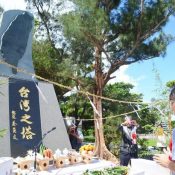
June 26, 2016 Ryukyu Shimpo
Taiwan No To monument was erected for Taiwan’s World War Two war dead, at the Peace Memorial Park in Mabuni, Itoman city. A completion ceremony was held on June 25. The fourth memorial service for the Taiwanese war dead was also held on the same day, and 60 people gathered to pray for peace as well as friendly relations between Japan and Taiwan in front of the new memorial monument.
The monument was begun by the General Incorporated Association of Japan Taiwan Peace Foundation in 2015 as the year marked the 70th year since the war. The property was provided by the Okinawa Yokuyukai and is located right next to the Kuge No To monument, which is also maintained by the organization. The front side of the monument is shaped like Taiwan.
According to the director of the foundation, Mitsuteru Kyo, the number of Taiwanese people whose names are inscribed on the monument is 34. It is possible more Taiwanese died in Okinawa, yet there has been little progress with surveying. The foundation plans to do maintenance on the property around the monument, including slopes, to be completed by August 15, the anniversary of the end of the war. A former member of the Taiwanese legislative assembly, Chounian Tsu, who attended the completion ceremony said, “the monument will serve as a bridge between Japan and Taiwan. We would like to carry over the history and create a world without wars.” The director of the foundation Kyo also stated, “we would like to build a monument in Taiwan as well.”
(English translation by T&CT and Sayaka Sakuma)
Go to Japanese
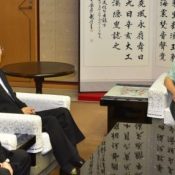
July 14, 2016 Ryukyu Shimpo
On July 14, Deputy chief cabinet secretary Kazuhiro Sugita visited Okinawa to attend a working group meeting between Okinawa and Japan concerning Okinawa’s revocation of its approval of land reclamation for the relocation of U.S. Marine Corps’ Futenma Air Station to the Henoko coastal area in Nago. Prior to the meeting, Sugita met Okinawa Governor Takashi Onaga at the Okinawa Prefectural Office. Referring to the matter of construction being forced the day after the Upper House election, Onaga told Sugita, “We can’t build a trustworthy relationship if the Japanese government forces through the helipad construction in Takae.” After the meeting, vice-governor Mitsuo Ageda spoke to the press. According to Ageda, Onaga stressed in the meeting that candidates supported by the All Okinawa have won major elections in Okinawa focusing on the Henoko relocation, including the Upper House election on July 10. Onaga claimed, “Okinawan people’s will is to prevent the new base construction in Henoko.”
(English translation T&CT)
Go to Japanese
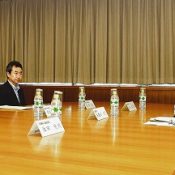
July 18, 2016 Ryukyu Shimpo
By Ryota Nakamura
Approximately ten hours after the polls closed in the Upper House election, riot police formed a human wall in front of the main gate to the U.S. military’s Northern Training Area in Takae, Higashi Village, and materials relating to helipad construction started being carried in. After Liberal Democratic Party politicians lost every Diet seat representing Okinawa in both the upper and lower houses, the national government has started on a course of antagonizing Okinawans, jumping to push forward the construction of U.S. military facilities—construction from which it had been refraining in order to avoid repercussions in the election.
A leading government official explained the forceful resumption of construction, saying, “There is no problem with resuming construction. This just happens to be the timing at which we will progress.” He explained construction became possible after entering into July, after the end of the nesting period of the noguchigera woodpecker, a species designated by the Japanese government for special protection. However, he also revealed that the resumption of construction was delayed out of consideration for the Minister of State for Okinawa Affairs, Aiko Shimajiri, who was facing an uphill battle after anti-base sentiment swelled among Okinawans due to numerous incidents and accidents involving the U.S. military, including the rape and murder of a woman by a U.S. military contractor.
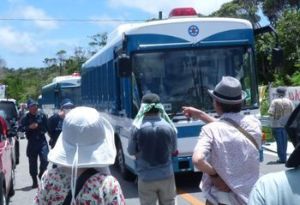
Chiba Prefectural Police riot squad vehicles pass by the gate to the training area while citizens protest the helipad construction (July 17, Takae Ward, Higashi Village, in front of the N1 zone gate to the U.S. miltary’s Northern Training Area)
In March of this year, after the national and prefectural governments agreed to a settlement in the Henoko relocation proxy execution lawsuit, the national government suspended construction at Henoko and put on a conciliatory face with an eye toward the Upper House election. In Takae, from March until June, it looked like the helipad construction had come to a standstill for the nesting period of the birds inhabiting the area.
However, behind the scenes, preparation was being carried out for the construction. Anticipating protests by citizens opposed to the construction, the government prepared to gather approximately five hundred riot squad personnel from the Tokyo Metropolitan Police Department and other police departments around the country to send to the construction scene.
Meanwhile, on June 23, the day after campaigning started for the Upper House election, the Ministry of Defense notified approximately sixty employees of their own ministry and local defense bureaus that they were to be stationed in Takae and Henoko as “security personnel” in response to protests at the two sites. The employees were also part of an “Okinawa/regional safety patrol unit” established to prevent recurring crimes after the murder incident by a U.S. military contractor, and were additionally assigned as security personnel.
The government plans to send a total of 560 security personnel to the sites of the protests. Regarding the fact that these preparations were made behind closed doors while the Upper House election was going on, a Ministry of Defense official revealed, “We weren’t facing an uphill battle—more like a typhoon. There was no question as to who would win [the Upper House election].”
Meanwhile, some people associated with the police and defense express a different view. One source involved in security grimaced as he referenced measures taken in 2014 to eradicate Kudo-kai, a registered dangerous yakuza group, in which 530 additional riot squad personnel were sent to the front lines. “These security efforts are the same scale as were used to eradicate the Kudo-kai. It is not normal to view gangsters with heavy weapons and ordinary citizens in the same light,” he said, expressing doubt toward the fact that the national government is taking the same confrontational stance toward ordinary citizens as it did toward dangerous gangsters.
After Shimajiri lost the Upper House election, politicians opposed to the Henoko base construction and backed by the “All-Okinawa” faction working with Governor Takeshi Onaga came to fill all six seats representing Okinawan electoral districts in both houses of the national Diet. Nonetheless, the government is barreling forward aggressively; as early as July 22, it plans to resume construction on land at Henoko and on the Takae helipads, and simultaneously plans to move forward with a new lawsuit against the Okinawan governor.
A member of All-Okinawa Kaigi (All-Okinawa Coalition) observes that the national government got a head start on Governor Onaga, who plans to call for a reduction of the base burden on Okinawa at a nation-wide meeting of governors on July 28 and 29. “They probably want to make a show of proclaiming that the governor is incapable of preventing the construction,” he said, expressing strong distrust and vigilance toward the national government.
(English translation by T&CT and Sandi Aritza)
Go To Japanese
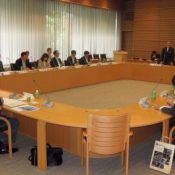
July 14, 2014 Ryukyu Shimpo
On July 14, a meeting of the National Governors’ Association (NGA) Special Committee for General Strategies and Government Oversight opened in Tokyo. At the meeting, the Special Committee agreed to establish a council body to discuss reduction of Okinawa’s base burden. An official decision on the matter will be made between July 27 and 29 at an NGA meeting in Fukuoka Prefecture.
Okinawa’s base problems became a topic of discussion at the Special Committee meeting. Vice-governor of Okinawa, Isho Urasaki, explained the historical background that formed Okinawa’s overlarge share of U.S. military bases and the current condition of U.S. bases. He requested the establishment of a place at which to discuss U.S. base issues as nationwide concerns. No dissenting opinion was presented. Details regarding the establishment of such a place are to be worked out by the time of the NGA meeting in late July, and already the Association is moving toward officially founding one.
After the Special Committee meeting, Vice-Governor Urasaki said, “Our whole nation should consider the U.S.-Japan relationship and related matters.” He hopefully mentioned that, “It will be good if each step [we take] is progress in a positive direction.”
(English translation by T&CT and Erin Jones)
Go to Japanese
July 13, 2016 Ryukyu Shimpo
The United States military and the government should cancel their plan to build helipads in the U.S. military’s Northern Training Area near Takae in Higashi Village.
The construction of helipads to be used by Osprey will harm not only the living environment of nearby residents, but also the habitats and ecosystems of the precious flora and fauna of the Yambaru area of northern Okinawa Island, which has even been considered a candidate for registration as a World Heritage nature site.
Early in the morning the day after voting was held for the Upper House election, the Okinawa Defense Bureau pushed forward with resuming the helipad construction, forcefully transporting materials into the construction site. Opposition to the helipad construction derives from the same sentiment as the overwhelming opposition to the Henoko new base construction plan, which was displayed in the Upper House election. It is hoped that Governor Onaga will clearly voice opposition to the helipad construction, which tramples upon the will of the people.
A blatant pre-election measure
The Defense Bureau avoided doing any work during the election campaign period, then jumped to resume construction the moment the votes were in. This was a blatant measure taken with the election in mind. They displayed not a hint of willingness to face voices of opposition from the people of Okinawa prefecture or local residents.
It is only natural that Governor Onaga announced, “[The Defense Bureau] conducted thorough preparations [to resume the construction] just hours after the will of the people was expressed in the election. That is unacceptable.”
The way in which the return of a part of the Northern Training Area was negotiated with the condition of relocating the helipads in exchange was highly problematic to begin with.
The return of a part of the Northern Training Area was included in the final report of the U.S.-Japan Special Action Committee on Okinawa (SACO) in 1996, and the condition of relocating the existing helipads was not decided based on discussions with the Okinawa prefectural government, local governmental bodies, or local residents.
Although a part of the facilities within the Northern Training Area that had become unnecessary to the U.S. military were to be returned, the vested interest of the existing helipads would be maintained. This is identical to the case of Futenma, in which U.S. Marine Corps Air Station Futenma, which has become difficult for the U.S. military to use due to the dangers of being located in the middle of a city, will be returned, but at the same time, the construction of a new base in Henoko is being pushed forward in order to maintain and fortify the military functions served by Futenma.
The “reduction of burden on Okinawa” is used as a pretext, but in substance, policies relating to U.S. bases in Okinawa are filled with deceit, serving to preserve and fortify facilities that serve the interests of the U.S. military.
Twenty years after the publication of the 1996 SACO report, U.S. military strategy has changed significantly. One major change is the decrease in relative importance of the U.S. Marines in Okinawa, as seen in the plan to relocate 9,000 Marines to Guam and other places outside Japan.
Although the majority of infantrymen, the nucleus of the key operational unit, will be moved to Guam, the Japanese government continues to cling to the idea of building a new base in Henoko, to be used by the transport helicopter unit. The Japanese government should fundamentally rethink the plan to build a new base in Henoko. It is only natural that they should also simultaneously rethink the relocation of helipads in the Northern Training Area. As a reduction in training is anticipated with the relocation of a large number of Marine Corps personnel to Guam, it makes no sense to maintain the current number of helipads. The government needs to get out of its rut of refusing to think.
Destruction of lives and ecosystems
Observers point to a problem that cannot be overlooked—when an environmental impact assessment was conducted prior to the helipad relocation, it did not assess the impact of use of the helipads by Osprey.
It is noted that Osprey have a significantly larger impact on the lives of residents and on the natural environment than conventional helicopters, due in part to low-frequency sound they emit. The environmental impact assessment was accepted despite being flawed in that it did not survey the anticipated impact of the Osprey.
In January of this year, Governor Onaga requested that the Okinawa Defense Bureau take twenty-two environmental conservation measures spanning eight categories, including a survey of the impact of noise and high-temperature heat exhaust emitted by Osprey on plants and animals inhabiting the affected areas.
It is utterly impermissible for the Defense Bureau resume construction on the helipads without so much as lending an ear to this reasonable request.
During the campaign leading up to the Upper House election, Osprey repeatedly conducted nighttime takeoff and landing exercises at the already-built N4 zone helipad in Takae, forcing local elementary and middle schoolers to miss school due to sleep deprivation.
Construction and use of the helipads is being pushed forward despite opposition from residents and concerns about their impact. Those concerns have become reality as the residents and children of Takae are now suffering harm equivalent to a violation of their human rights.
Prior to the gubernatorial election two years ago, Governor Onaga stated regarding the Takae helipads, “I oppose [them] in line with my demand for the removal of the Osprey.” From the perspective of protecting the human rights of Okinawans and the precious nature of the northern part of the island, Governor Onaga should take a resolute stand in opposition to the helipad construction.
(English translation by T&CT and Sandi Aritza)
Go to Japanese

July 12, 2016 Ryukyu Shimpo
At 6:00 a.m. on July 11, one night after the Upper House election ended, the Okinawa Defense Bureau re-started preparation work for construction of U.S. Marine Corps helipads in Takae, Higashi.
About 100 riot police and about 20 security guards employed by the defense bureau were mobilized in front of the main gate of the Northern Training Area, despite there being few protestors at the site initially.
The defense bureau put up barriers around an open area where residents and protestors have held meetings.
The scene subsequently became tense, with scuffles breaking out between protestors, who were trying to remove the barriers, and the riot police.
The civilians voiced anger against construction being forced the day after the Upper House election ended.
About 60 protesters gathered objected that the vacant ground is a part of prefectural road No.70, which is under the administrative control of the prefectural government, and that it is illegal for the defense bureau to set up the barriers without gaining permission from the prefectural government. They demanded the defense bureau remove the barriers after confirming that it had not submitted an application for the use of the vacant ground to the prefectural government.
They claimed the defense bureau had no authority to enclose the vacant ground, which is beyond the military area where there are signboards banning trespassing. Protestors have long had meetings and break times there without ever being told to leave.
The northern regional office of the prefectural government’s civil engineering and construction department told the Ryukyu Shimpo reporter that it is investigating whether the area where the barriers are now located is under the control of the prefectural government or not.
The defense bureau claimed that the site is located within the U.S. facilities and that it was therefore not necessary to gain permission from the prefectural government.
Higashi Village Council member Shinji Isa said, “The Abe administration takes an abnormal approach, disregarding the will of the people. We cannot allow them to do such things.”
Gentatsu Ashimine, a resident protesting against the construction of the helipads, vowed to take strong action and block the materials for the construction from being brought into the site.
(English translation T&CT)
Go to Japanese
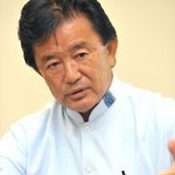
July 12, 2016 Ryukyu Shimpo
On July 11, Ryukyu Shimpo invited former mayor of Ginowan City and newly elected independent to the Okinawa At-large district of the House of Councillors to the Ryukyu Shimpo head office, Yoichi Iha, to ask him about Futenma Air Station relocation and constitutional reform, among other topics. Chief editor Hitoshi Fukuhara asked the questions.
– What are your feelings on being elected for the first time and what have you decided as a course of action in the National Diet?
“Using my experience up to the present, I want to shift entrenched national politics toward making efforts to abandon the plan of a new base in Henoko.”
– Tell us more about your victory by a 100,000-vote margin.
“Okinawans’ anger is rising against the Abe administration forcing military bases on Okinawa. One after another votes for me added up due to [voters’] sentiments that they would never elect my opponent.”
– What was the focal point of your platform?
“The abandonment of a new base in Henoko. Since Okinawans will certainly not accept construction of a new base in Henoko, from here on out I will resiliently demand [abandonment of the plan].”
– How exactly will you accomplish this?
“Facing off with the Government of Japan, I will strongly request that it recognize Okinawan regional authority. To the point of exhaustion I will resolutely insist that [the government] cannot go against Okinawan citizens’ wishes, and moreover force military bases [upon Okinawa].
The United States should make the Abe administration reconsider [concerning a new base in Henoko], parallel to the thinking of former Secretary of Defense Donald Rumsfeld that the U.S. does not put bases ‘where [they] are not wanted.’ It is important to directly address Congress concerning how the current state of bases in Okinawa flouts democracy.”
– What about deployment of Self-Defense Forces to the Sakishima Islands?
“I oppose it. I hope for the development of a situation in which China and Japan can peacefully communicate. It is essential that the Senkaku Islands issue be settled through diplomatic efforts.”
– Constitutional reform has been the most prominent point at hand nationally. By what means will you stand in the way of constitutional change?
“It is important that Japanese citizens firmly grasp the significance of and principles behind Article 9 of the Constitution. In order to maintain Article 9, it is essential to continue pursuing harmonious diplomatic relations with China.”
– What about economic problems?
“We must treat the tourist industry with care, and furthermore strive to get Asian people to travel [to Okinawa].”
– Will you take independent action in the National Diet?
“Politically ‘independent,’ yes. If a political faction can be formed in the National Diet I want to do just that. Within the current political efforts for the sake of Okinawa, will it not be possible to build upon [the movement]? If possible, it would be best to have an ‘Okinawa Party.’ The term ‘All Okinawa’ can be given new life.”
(English translation by T&CT and Erin Jones)
Go to Japanese










 Webcam(Kokusai Street)
Webcam(Kokusai Street)


